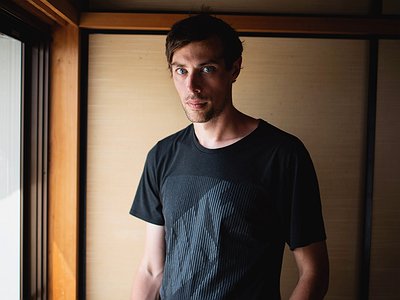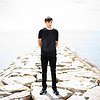Part 2
Could you take us through a day in your life, from a possible morning routine through to your work? Do you have a fixed schedule? How do music and other aspects of your life feed back into each other – do you separate them or instead try to make them blend seamlessly?
Wake up around 7/7:30am, coffee, meditation, run, shower, more coffee, check my emails. Brunch late morning/midday. From there there’s so much variation, depending on what I’m doing. I’ve been doing some writing and arranging sessions with my clarinet player Rachel Coombes at her college in Oxford. If I’m just mixing or refining ideas I’ll sit and work with my headphones in my lounge, or if I’m working on new ideas I’ll get stuck in with the keyboards. If I’m working with Neon Dance we tend to do roughly 10–6 in the studio, and I’ll have an hour to play with musical ideas while the dancers are warming up between 10 and 11am. If we’re on tour it’s a whole other kettle of fish, I try and keep up the healthy lifestyle as much as possible. I find cold showers really good for helping to deal with stress, and for helping with the recovery from jetlag.
Could you describe your creative process on the basis of a piece or album that's particularly dear to you, please? Where did the ideas come from, how were they transformed in your mind, what did you start with and how do you refine these beginnings into the finished work of art?
I have a few different ways of working, that have been informed by the various musical projects that I’ve been involved in over the years. To give an example of one way, I’ll describe the process behind my track Holy Island. Holy Island is based around a piano melody that repeats and adds or subtracts a beat as it cycles through the chords. I originally came up with the idea and basic part probably in 2001 or 2002 roughly. The idea lay dormant in my mind for about 10 years or more, and then in 2013 or 2014 I started jamming it a bit with the bands that I was in, The Epstein and Flights of Helios. It never progressed beyond an occasional jam in the rehearsal room, it was never performed live with either act.
I started visiting Berlin in 2015, and I happened to meet the cellist Anne Müller, I played her the part and she quite liked it, she agreed to work on the piece that would become Holy Island, and to develop the arrangement. I came up with the second section where it modulates from D to A, and the opening and closing wash of F sharp major. A friend and collaborator in Oxford, Andrew Warne, who played some of the guitar parts for it, suggested trying to vary the way that the main melody repeats throughout the track. Anne helped me record and edit a basic piano track, and she laid down her beautiful cello parts, and I further developed the piece with some processing of atmospherics and sounds sent in by Andrew and Jon Ouin.
I did the final mix with Mike Bannard at The Aviary and Safehouse studios in Oxford. Although I love this version which I’ve described that appears on the Solo Collective Part 1 record with Anne Müller and Alex Stolze, I insisted that we record a new version of the three of us performing Holy Island as we had developed it for our live Solo Collective performances, with Alex’s additional beautiful melodies. I still don’t feel like the piece is finished business, and I dare say there will be further versions in the future. I think a lot of artists find it tormenting to have to settle on any given recording as being the definitive version of a piece, when sometimes they can have so much more to give.
There are many descriptions of the ideal state of mind for being creative. What is it like for you? What supports this ideal state of mind and what are distractions? Are there strategies to enter into this state more easily?
One of the interesting parts of being a creator is to explore and externalise different states of mind, from the ridiculous to the sublime, and everything in between. Of course, certain projects call for certain moods, and one would want to try and contrive to be in certain states in order to capture certain atmospheres, but sometimes it’s interesting to be a prisoner of circumstance and see what comes up in response to a situation, either internally, externally, or both. There’s always an element of not forcing something, I’ve found it counterproductive to try and push oneself to try and create a certain mood if it’s not where one is at so to speak. I’m so accustomed to working with the circumstances as they are I couldn’t entirely describe consciously what facilitates the presence of a ‘flow state’ as it’s sometimes called.
How is playing live and writing music in the studio connected? What do you achieve and draw from each experience personally? How do you see the relationship between improvisation and composition in this regard?
I really like using improvisation in the recording environment, jamming in the studio or jamming with pre-recorded sounds using a tool like the Ableton Push controller. And also, being able to trigger pre-recorded material in a live context in a very spontaneous way is very exciting. Often even if I’m just playing around with ideas in Ableton I will be very spontaneous with it, improvising keyboard ideas over the top of themselves, layering with samples and beats etc in a very in the moment way, without having pre-planned anything consciously. Other times I’ll start from a pre-planned idea but I’ll always leave the door open for going off on tangents. When I’m working with other musicians to capture tunes that are much more tightly composed and pre-planned there’s still the magic of trying to capture a moment together that has the tightrope walking tension and magic. You can hear a good representation of this thin line between composition and improvisation in the studio on my piece One Year On, as featured on Solo Collective Part 2.
Anne and Alex and I were touring together in the UK, and we took a day off to do some recording, I came up with the piano motif for One Year On on the spot, and we spent a pretty short amount of time working out ideas for the strings and an overall arrangement before we recorded a series of takes, one of which ended up being the version that we released. Anne and Alex are such top-class musicians that they can very spontaneously create music that sounds accomplished and yet free and expressive, it’s an honour to be able to play with them and it suits my open-minded approach to working with other musicians, I always want to be able to leave room for a performer to bring their own ideas to the table.
It's also worth pointing out that a mark of intellect across the animal kingdom, humans included, is the urge to play, in juveniles and adults, as a process of learning. Sometimes it’s good to be in a high-stakes, high pressure environment such as an expensive recording studio or a live performance context to put you in the zone as they say, but sometimes I’ve come up with my best ideas in the most relaxed of environments, just playing around with some ideas in Ableton in my lounge. The irony is always that you might well do your best work when you don’t feel at all like you’re working, just playing.
How do you see the relationship between the 'sound' aspects of music and the 'composition' aspects? How do you work with sound and timbre to meet certain production ideas and in which way can certain sounds already take on compositional qualities?
Ever since the birth of electronic musical instruments and the prevalence of ever more sophisticated means of recording sound and then being able to process it in such a multitude of flexible, creative ways, the line between sound design and composition has blurred considerably. Whether one is scoring an orchestral piece, making an electronic drone piece, or anything in between, the question comes down to what am I trying to say or express with this piece, and what tools of sound best service this expression?
Our sense of hearing shares intriguing connections to other senses. From your experience, what are some of the most inspiring overlaps between different senses – and what do they tell us about the way our senses work? What happens to sound at its outermost borders?
I think true art in any medium can shift one’s consciousness entirely beyond the sense realms altogether, and facilitate an experience of transcendence.
Art can be a purpose in its own right, but it can also directly feed back into everyday life, take on a social and political role and lead to more engagement. Can you describe your approach to art and being an artist?
I think the greatest role of art is to offer beauty and the potential for transcendence. The problem with politicising art is it risks cheapening it, and debasing it of its greatest potential. In the worst case it can become nothing more than cheap propaganda made by someone who doesn’t even understand properly the causes that they profess to be championing. Being a talented musician who is very empathetic to those suffering is separate from having a proper, sophisticated understanding of what are often unspeakably complicated issues, with innumerable unintended consequences that could end up being equally if not even more harmful than whatever one is moved to protest or campaign for or against. So easy to confuse one’s personal psychological issues with the political or social issues of the day.
It is remarkable, in a way, that we have arrived in the 21st century with the basic concept of music still intact. Do you have a vision of music, an idea of what music could be beyond its current form?
I think it’s remarkable that we’ve had such an explosion of musical forms, genres and sub genres in the 20th Century and beyond. A Cambrian explosion of sorts. What’s interesting is that, on the one hand the changes that started in music around the turn of the 20th Century are incredibly nebulous and complicated, but in some ways can still be boiled down to certain primal human drives, which have been with us for the few million years of our evolutionary process. We’re continuing to discover ever new ways to express a handful of eternal truths.






